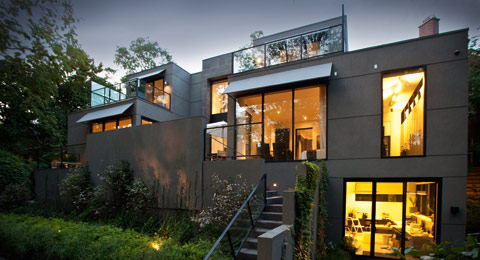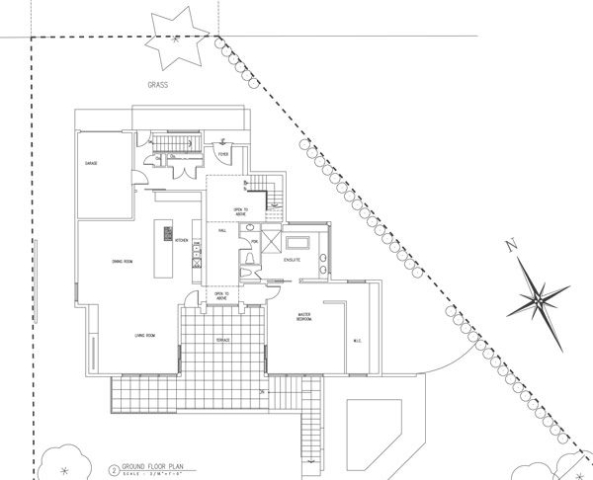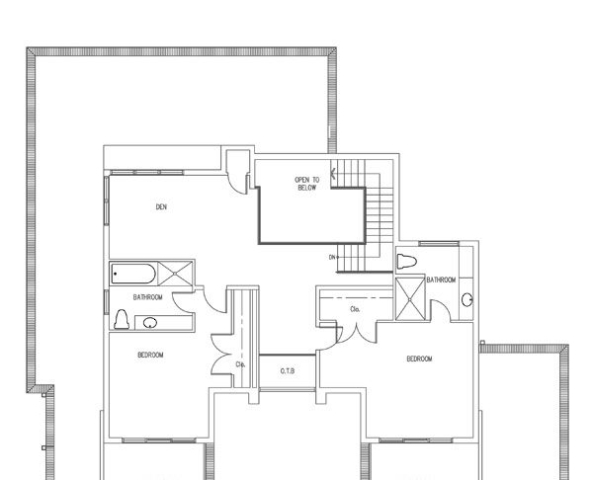Iz pera arhitekte
Autor: arh. Miloš Pavlović
Fotografije: Steven Miric
Vila na Čaplinovom bregu, u Torontu, jasno uspostavlja i potvrđuje svoju “kolonizatorsku” nameru i stav. Razumeti arhitekturu kao akt “kolonizacije”, znači zauzeti poziciju negde na pola puta između produkcije arhitekture kao čistog, autonomnog objekta i produkcije arhitekture kao čistog i kompresovanog umetanja u postojeći kontekst. “Kolonizovati” ukratko znači okupirati teritoriju. Ali, “kolonizovati”, u vecini slučajeva znači i okupirati silom, nametnuti novi režim ili drugačiji red na okupiranom mestu. Međutim, u oba slučaja, kolonizacija meri sebe prema okupiranoj teritoriji i uspostavlja sebe prema prethodniku, tako što postaje kombinacija nametnute sile i promišljene dogradnje. Ova kuća je, ukratko, stigla izrično i ciljno na to mesto – da se tu skrasi i uspostavi “novi poredak” (New Order). Ona očito kao da izrasta na vrhu brega, jednovremeno kolonizujući gestikulaciju zatečene topografije koja je, za uzvrat, ovom intervencijom samo dobila snažan oslonac i okrepljenje.
Akt kolonizacije je uvek konfrontacija – preuzimanje određenih referenci sa namerom da se proizvede novi prostorni sistem. Slično Marsel Dišanovom (Marcel Duchamp) Object trouve, kuća na Čaplinovom bregu je inkorporirana kao talog, gotovo kao arheologija memorije, u novu organizaciju i sistem. Postojeće arhitektonsko nasleđe, iz neposrednog okružja na bregu, je s predumišljajem pretvoreno u nešto drugo, u druge vrednosti. Dominacija trouve-a, po mom mišljenju, nikada ne ostavlja ni najmanji prostor za sumnju.
Kroz ovu arhitektonsku ideju ne čini se ni najmanji pokušaj da se kuća upari sa kvazi-istorijskim detaljima suseda, koji se šnažno oslanjaju na mnoštvo kolonijalnog nasleđa viktorijanske Engleske. Nasuprot tome, opredeljuje se za urbanu interpunkciju među susedima.
Osetan prostorni kontinuitet biva pojačan jednostavnim, čistim detaljima, ekspresivnim, konstruktivnim rečnikom samog objekta, distrubucijom volumena, obiljem prostora i prirodnog svetla koje stiže u enterijer vile kroz visoke, dvospratne prozore (zid-zavesu) koji obdaruju ovaj objekat svojevrsnim senzualitetom i toplinom. Dvoipospratni ulazni atrijum je postavljen u centar vile, sa konzolnom bibliotekom na gornjem spratu – koja je projektovana sa intencijom da bude polu-skrivena od pogleda iz atrijuma. Atrijum, u pravcu zadnje fasade, pretapa se i postaje visoka, linearna galerija koja izlazi direktno u uzvišeno, eksterijerno dvoriste. Slično klasičnoj rimskoj vili, u kojoj nije neophodno da i fizički budete prisutni u dvorištu da biste imali udeo u njemu.
Ovde, ova namerno uspostavljena međusobna veza sa svim delovima vile, isporučuje kontemplativnu i ekspicitnu intimnost dizajna koju jednostavnost detalja ničim ne može da ugrozi.
Kao naš odgovor na prirodni, strmi pad samog terena, izgrađeni prostori vile su funkcionalno razbijeni u povezani niz volumena koji su, dalje, u blisko uspostavljenoj vezi, kako sa topografijom terena, tako i sa vizurama. Taj prilično zakošeni teren, relativna bliskost susednih placeva, kao i različiti stepeni učešća klijenta su, svaki ponaosob, dominirali procesom projektovanja. Počevši od prvih skica, izraženi dinamizam je rukovodio ovaj projekat u različitim smerovima. Spomenuti dinamizam je uspostavio jasno zacrtan pravac koji je definisao odnos vile i samog terena. Multiplikovana uputstva i direkcije, silazni pokret vile niz breg, ubedljiva geometrija, su svi zajedno, dali svesrdnu podršku aktivnoj, gotovo agresivnoj okupaciji mesta i pejzaža.
Pristupna, ulična fasada Vile Trouve predstavlja javno lice vile, sa tri markantna i jasna ulaza: automobilski, pomoćni i glavni ulaz. Zadnja fasada je umerenija, privatno lice vile, sa uzvišenim otvorenim dvorištem – koje je de facto svojevrsni epicentar vile. Izdignuto dvorište takođe doprinosi formiranju sveprisutnog prostornog kontinuiteta i omogućava postepeno spuštanje niz kosinu brega u baštu, uspevajući na taj način da produži i uspostavi aktivan uticaj vile na neposrednu okolinu.
Akt kompresovane kolonizacije, kako u ovom, tako i u mnogim drugim projektima mog biroa Studio Pyramid, uvek je čin namerne konfrontacije sa ciljem da se proizvedu novi prostorni sistemi.
The Architect’s Pen
Author: arch. Miloš Pavlović
Photo: Steven Miric
The first impression of the Villa on Chaplin’s hill, in Toronto, is that it clearly establishes and confirms its colonial attitude and intention. Perceiving a work of architecture as an act of “colonization” requires understanding the distinction between a clearly autonomous architecture and an architecture which is neatly and sympathetically inserted into its existing context. To “colonize”, in short, means to occupy territory, but in most cases it means territorial occupation by force – through the imposition of a new regime or a different order in the occupied area. However, in both cases, colonization measures itself in relation to the occupied territory and becomes established, in relation to the predecessor, when conceived of as a combination of imposed force and a perspicacious “grafting”. This house is here, on this targeted location, to stay and to establish a “New Order”. It rises prominantly from the hill top, and so visually colonizes the existing topography which now becomes something different, strengthened and renewed through the intervention.
The act of colonization is always one of confrontation, the adoption of particular references in order to produce a new spatial system. Similar to Marcel Duchamp’s Object trouve, the house on Chaplin’s hill was incorporated into a new system and organisation almost like an residual archaeological memory. The existing architectural heritage of the surroundings is intentionally transformed into something different, with new values of its own. In my opinion, there is no doubt about Trouve’s domination.
No attempt was made to match this house with the quasi-historical details of its neighbours which are steeped in a strong colonial legacy from Victorian England. Instead the idea was to create a punctuation mark between them, similar to an act of urban “acupuncture”.
The Entrance atrium, which rises two and a half storeys high, is located at the center of the villa. On top of this is the console library which was designed to be partly hidden from view. The atrium continues through to the rear facade and forms a high linear gallery which extends directly into the elevated, exterior courtyard. In a similar fashion to the classic Roman villa ,where adjacent spaces to the courtyard could occupy it, from a distance, here an intentional interconnectedness of all the parts of the villa, promotes an intimate and contemplative atmosphere which is in harmony with the simplicity of the details.
The response to the natural steep terrain was to build functionally divided spases that are connected through a series of volumes and which are closely related with both the topography of the terrain and its viewpoints. The inclined terrain of the site, relative proximity of the land, and participation of the clients, were the dominant factors which defined the design process. Starting from the first sketches, an expressive dynamism led the project in different directions. It was that dynamism which eventually produced one clearly defined direction as well as being responsible for the tension in the villa, and its dynamic relationship with the surrounding terrain.
The dominant, almost aggressive, occupation of the site and the landscape is a result of the strong geometry of the design and the confidence with which it embraces the downward movement of the terrain.
The street side facade of Villa trouve is the public ‘face’ of the villa and has three distinctive entrances: a main, an automotive and an auxiliary. The rear façade or private face of the villa is more relaxed and features an elevated open courtyard which is de facto a kind of epicenter of the villa. It is the heart of the villa in more ways than one and essential to the creation of a spatial continuity which flows through the building, down the hill and out into the garden, thereby extending the presence of the villa beyond its physical boundaries and asserting itself in its environment.
The act of concentrated colonization, both in this and in many other projects of my bureau Studio Pyramid, is always an act of deliberate confrontation, with the aim of creating new spatial systems.









